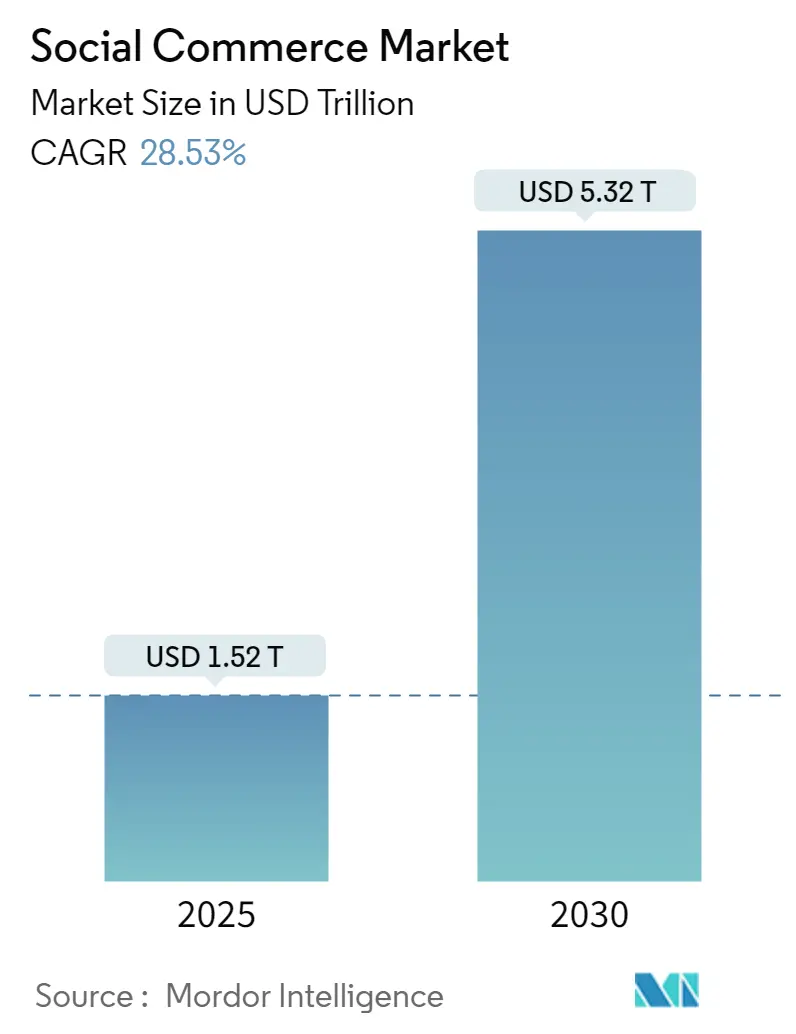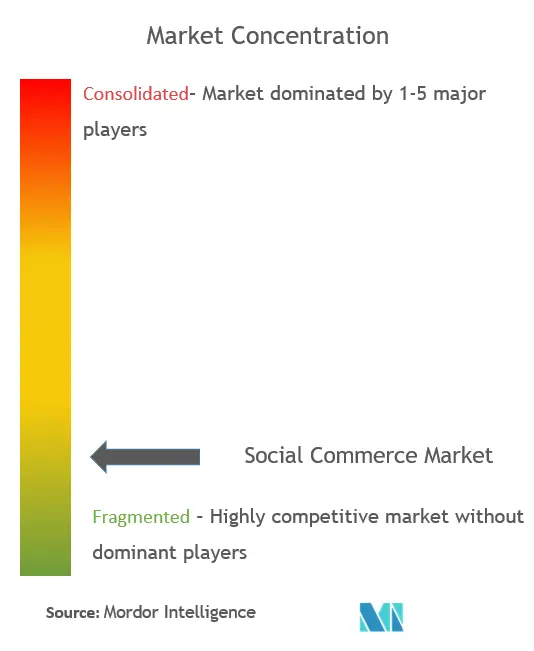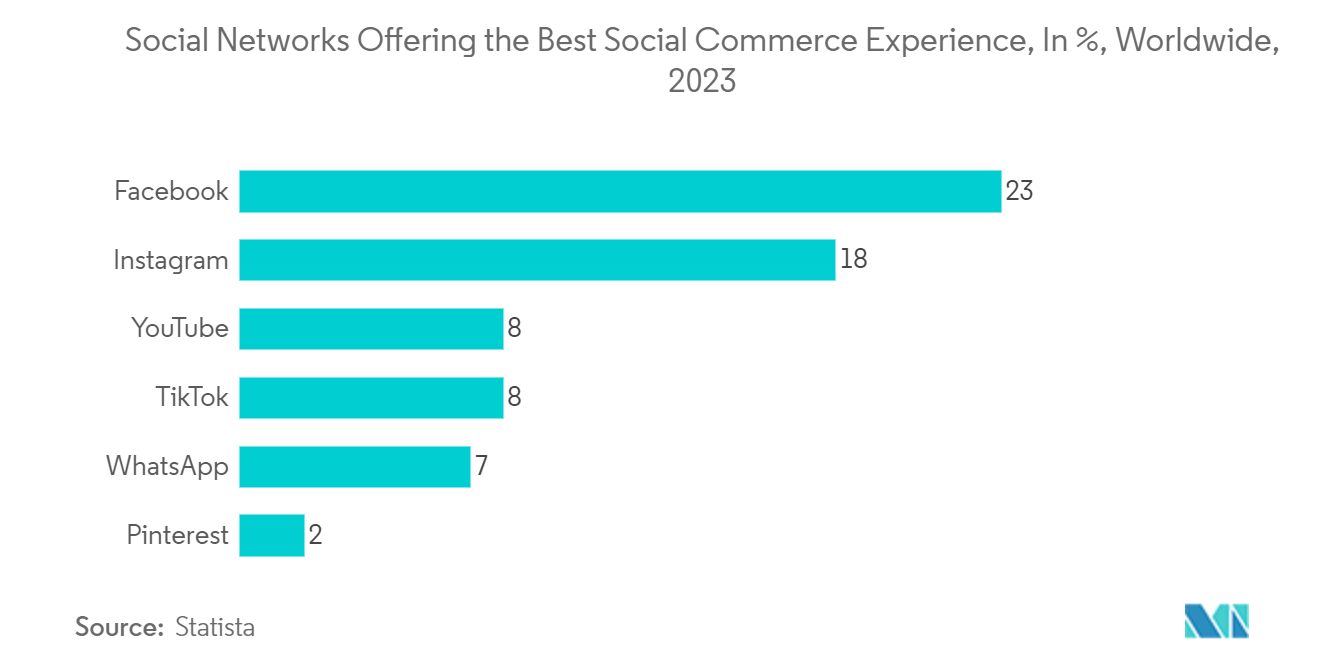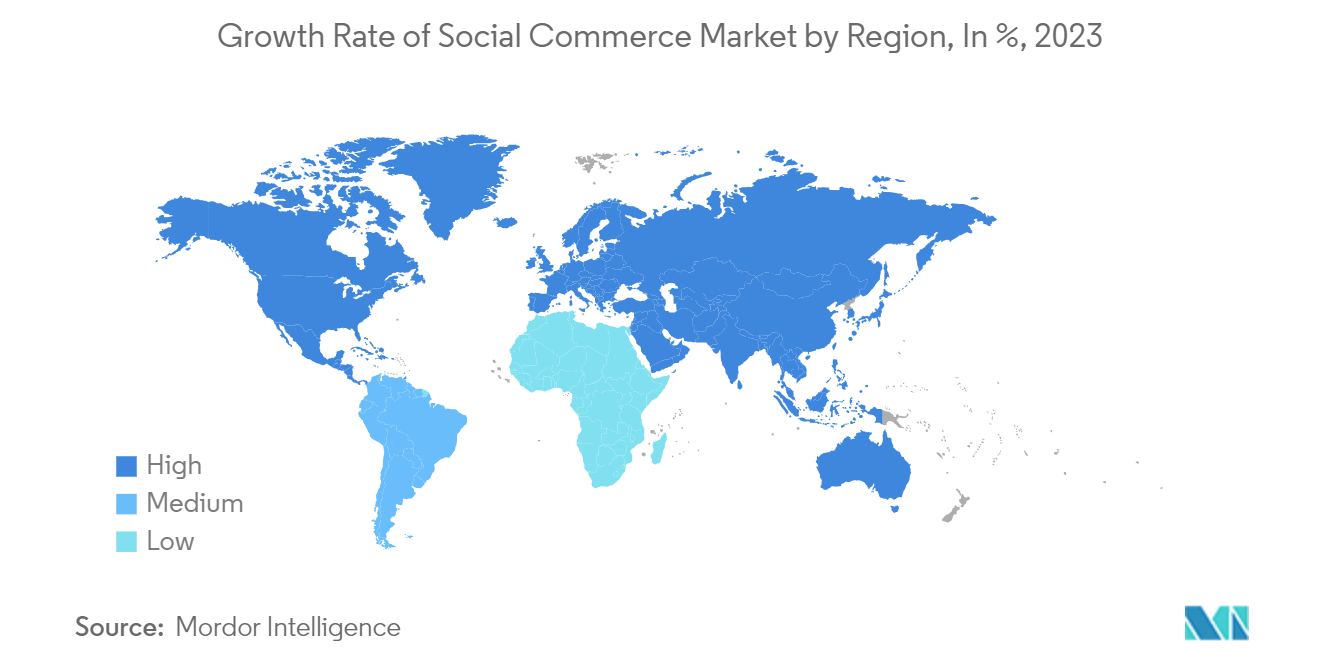
| Study Period | 2020 - 2030 |
| Market Size (2025) | USD 1.52 Trillion |
| Market Size (2030) | USD 5.32 Trillion |
| CAGR (2025 - 2030) | 28.53 % |
| Fastest Growing Market | North America and Europe |
| Largest Market | Asia Pacific |
| Market Concentration | Low |
Major Players
*Disclaimer: Major Players sorted in no particular order |
Social Commerce Market Analysis
The Social Commerce Market size is estimated at USD 1.52 trillion in 2025, and is expected to reach USD 5.32 trillion by 2030, at a CAGR of 28.53% during the forecast period (2025-2030).
Social commerce aims to expedite purchasing by removing needless extra stages and enabling clients to shop and check out immediately via social media networks. The market is anticipated to grow due to the widespread adoption of easy product discovery, checkout, and shopping processes. During the forecast period, a rise in potential customers from various social media platforms, including Facebook, Instagram, Snapchat, and Pinterest, is anticipated to propel market growth.
Social commerce made the integration of content sharing, payment processing, messaging, and buying possible. High levels of impulse buying, particularly among Gen Z and millennials, combined with easy access to social media networking sites have generated enormous potential for many businesses and sellers to boost sales, which will draw in new clients. Additionally, social commerce allows brands and merchants to combine social media with e-commerce platforms, creating a big branding opportunity. This has improved brand exposure on social media and made it possible for consumers to remember the brand through consistently interesting material. Due to the new opportunities it has created for individuals and small enterprises, social commerce has grown to be a driver for democratization. Consumers are more inclined to purchase from small businesses than from e-commerce websites when using social commerce.
Social Commerce Market Trends
Growing demand for business-to-consumer (B2C) social commerce is driving the market growth
The business-to-consumer (B2C) segment dominates the social commerce market because of its sizeable customer base, chances for consumer involvement, social media recommendations, powerful purchasing habits, smooth mobile experience, and capacity for building direct client relationships.
Lately, there has been a growing demand for social networking platforms for direct e-commerce transactions with customers. Social networking sites have become practical tools for businesses to promote their brands and make money. Consumers' increased use of social media platforms has enabled companies to reach a large audience. Social media sites like Facebook, Instagram, Pinterest, TikTok, and others have millions, if not billions, of active users, making them attractive B2C markets. Customers want immediate assistance, and with mobile technology developing rapidly, they are searching for new ways to interact with brands through digital platforms. With more than 60% of purchases completed through social media platforms, younger generations, such as millennials and Gen Z, are prevailing in social commerce.
Owing to its large population, digital payments, and influential social media platforms Asia-Pacific leads the market
The expansion of Asia-Pacific has been fueled by increased disposable income, a huge youth population, and improved network connectivity. The expansion of social media platforms beyond Facebook, TikTok, WeChat, and Youtube, as well as the widespread use of mobile devices, have all helped to fuel the rise of the social commerce industry in this area.
Due to a sizable population that uses social media platforms to make purchases, China has the largest social commerce market in the world. Through their social media platforms, major technology companies like Tencent Holdings Ltd and PDD Holdings Inc. have captivated a sizable portion of the population in China and Southeast Asia. Overall, with many consumers and businesses adopting social media for commerce, the region is expecting growth in the forecast period.
Social Commerce Industry Overview
Companies in the highly competitive and fragmented social commerce market are concentrating on strengthening their relationships with retail stores and distribution networks to expand their consumer base. Leading companies constantly invest in R&D to create new products and technology to stay competitive. Some top players in the market include Instagram, Facebook, YouTube, TikTok, and Pinterest.
Social Commerce Market Leaders
-
Instagram
-
Facebook
-
YouTube
-
TikTok
-
Pinterest
- *Disclaimer: Major Players sorted in no particular order

Social Commerce Market News
- November 2023: Amazon announced a partnership with Meta (Facebook’s parent company) to revolutionize social commerce. This collaboration aims to integrate Amazon’s e-commerce platform with Meta’s social media platform, providing shoppers with a seamless purchase experience and opening new opportunities for targeted advertising.
- April 2023: Amazon and Pinterest partnered to deliver third-party ads on Pinterest’s platform. The partnership aimed to make every pin shoppable by integrating Amazon’s e-commerce platform with Pinterest’s social media platform.
- December 2022: Amazon announced the release of Inspire, a new short-form photo and video feed that lets users browse ideas and goods while shopping from content made by brands, influencers, and other users.
Social Commerce Industry Segmentation
A quickly expanding subset of e-commerce known as "social commerce" uses digital media and social networks to streamline transactions between companies and clients. The social commerce market is segmented by business model, product type, sales channel, and geography. By business model, the market is segmented into business-to-consumer (B2C), business-to-business (B2B), and consumer-to-consumer (C2C). By product type, the market is segmented into personal and beauty care, apparel, accessories, home products, health supplements, food and beverages, and other product types (toys, DIY, electronics, and furniture). The market is segmented by sales channel into video commerce, social network-led commerce, social reselling, group buying, and product review platforms. The market is segmented by geography into North America, Asia-Pacific, Europe, South America, and the Middle East & Africa. The report offers the market size for the social commerce market in value terms in USD for all the abovementioned segments.
| By Business Model | Business to Consumer (B2C) | ||
| Business to Business (B2B) | |||
| Consumer to Consumer (C2C) | |||
| By Product Type | Personal and Beauty Care | ||
| Apparel | |||
| Accessories | |||
| Home Products | |||
| Health Supplements | |||
| Food and Beverages | |||
| Other Product Types | |||
| By Sales Channel | Video Commerce | ||
| Social Network-Led Commerce | |||
| Social Reselling | |||
| Group Buying | |||
| Product Review Platforms | |||
| By Geography | North America | United States | |
| Canada | |||
| Mexico | |||
| Rest of North America | |||
| Europe | United Kingdom | ||
| Germany | |||
| France | |||
| Russia | |||
| Italy | |||
| Spain | |||
| Rest of Europe | |||
| Asia-Pacific | India | ||
| China | |||
| Japan | |||
| Australia | |||
| Rest of Asia-Pacific | |||
| South America | Brazil | ||
| Argentina | |||
| Rest of South America | |||
| Middle East &Africa | United Arab Emirates | ||
| South Africa | |||
| Rest of Middle East & Africa | |||
Social Commerce Market Research FAQs
How big is the Social Commerce Market?
The Social Commerce Market size is expected to reach USD 1.52 trillion in 2025 and grow at a CAGR of 28.53% to reach USD 5.32 trillion by 2030.
What is the current Social Commerce Market size?
In 2025, the Social Commerce Market size is expected to reach USD 1.52 trillion.
Who are the key players in Social Commerce Market?
Instagram, Facebook, YouTube, TikTok and Pinterest are the major companies operating in the Social Commerce Market.
Which is the fastest growing region in Social Commerce Market?
North America and Europe is estimated to grow at the highest CAGR over the forecast period (2025-2030).
Which region has the biggest share in Social Commerce Market?
In 2025, the Asia Pacific accounts for the largest market share in Social Commerce Market.
What years does this Social Commerce Market cover, and what was the market size in 2024?
In 2024, the Social Commerce Market size was estimated at USD 1.09 trillion. The report covers the Social Commerce Market historical market size for years: 2020, 2021, 2022, 2023 and 2024. The report also forecasts the Social Commerce Market size for years: 2025, 2026, 2027, 2028, 2029 and 2030.
Our Best Selling Reports
Social Commerce Industry Report
Statistics for the 2025 Social Commerce market share, size and revenue growth rate, created by Mordor Intelligence™ Industry Reports. Social Commerce analysis includes a market forecast outlook for 2025 to 2030 and historical overview. Get a sample of this industry analysis as a free report PDF download.






